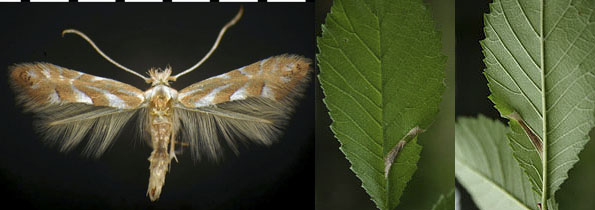
NOTE: for coverage of "Phyllonorycter" robiniella, morrisella, and uhlerella, see Genus Macrosaccus.
Phyllonorycter is a large genus of small, usually brightly-colored gracillariids, most species of which live as larvae in underside tentiform leaf mines, mostly on woody plants. Leaf mines of most species first appear in July and become more numerous with succeeding generations into early autumn, the larvae of the wintering generation being the most numerous. The larva remains inside the mine to pupate. The white markings of the forewing are margined black along their basal (inner) edges, in contrast to moths of the other large lithocolletine genus, Cameraria, in which the white marks are margined with black along their apical (outer) edges.
Phyllonorycter argentinotella (Fig. 1) is a leaf miner on elm, Ulmus sp. (Ulmaceae).

Figure 1. Phyllonorycter argentinotella. Adult, and top and bottom views of the leaf mine on elm, Ulmus sp. (Ulmaceae).
The larva of Phyllonorycter mariaeella (Fig. 2) makes a typical underside tentiform mine on various species of the honeysuckle family (Caprifoliaceae), including honeysuckles, Lonicera spp., snowberries, Symphoricarpos spp., and horse gentians, Triosteum spp.

Figure 2. Phyllonorycter mariaeella. Adult, and leaf mine on snowberry, Symphoricarpos sp. (Caprifoliaceae).
Another Caprifoliaceae-feeding species, Phyllonorycter symphoricarpaeella (Fig. 3), apparently feeds only on snowberry, Symphoricarpos sp. Its leaf mine tends to be relatively narrower than that of P. mariaeella on the same plant.
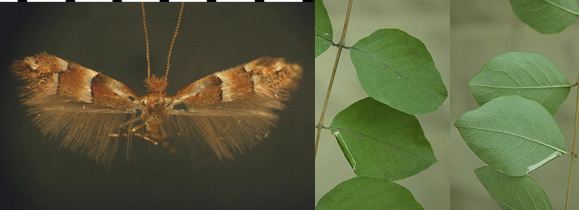
Figure 3. Phyllonorycter symphoricarpaeella. Adult, and leaf mine on snowberry, Symphoricarpos sp. (Caprifoliaceae).
The adult of Phyllonorycter tritaenianella (Fig. 4) somewhat resembles P. mariaeella and P. symphoricarpaeella, but the larva of P. tritaenianella feeds on hop hornbeam, Ostrya virginiana (Betulaceae). It is unusual within Phyllonorycter in that it mines the upperside of the leaf. The developing mine is very distinctive, appearing as a flat blotch with a characteristic thin, white upper surface (which renders it easily distinguishable from the mine of another lithocolletine, Cameraria ostryarella, in which the upper surface is thicker and yellower). By the end of larval development, the mine of P. tritaenianella becomes tentiform as usual for the genus, except that, as mentioned, it is on the upperside of the leaf.
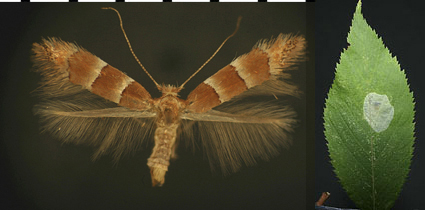
Figure 4. Phyllonorycter tritaenianella. Adult, and developing leaf mine on hop hornbeam, Ostrya virginiana (Betulaceae).
Like P. tritaenianella, the larva of Phyllonorycter obscuricostella (Fig. 5) feeds on Ostrya virginiana, but it makes an underside tentiform mine as is typical for the genus. Yet another species, P. ostryaefoliella, is also an underside tentiform miner on hop hornbeam.
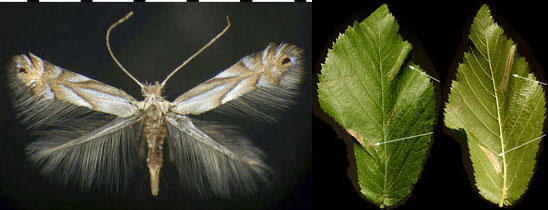
Figure 5. Phyllonorycter obscuricostella. Adult, and leaf mines on hop hornbeam, Ostrya virginiana (Betulaceae).
A third Ostrya-feeding Phyllonorycter species, Phyllonorycter ostryaefoliella (Fig. 6), makes a typical underside tentiform leaf mine, as does P. obscuricostella

Figure 6. Phyllonorycter ostryaefoliella. Adult, and leaf mine on hop hornbeam, Ostrya virginiana (Betulaceae).
Phyllonorycter celtifoliella (Fig. 7) feeds in an underside tentifom mine on hackberry, Celtis occidentalis (Ulmaceae). According to Braun (1908), this species is rare in the eastern USA, where the other hackberry-feeding species, P. celtisella (see below), is common. In central Illinois, the reverse is true, as P. celtifoliella is noticeably commoner than P. celtisella.
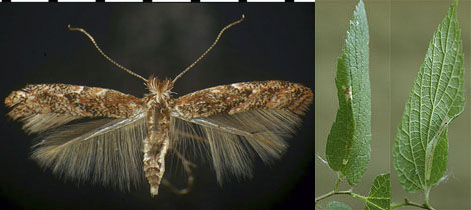
Figure 7. Phyllonorycter celtifoliella. Adult, and leaf mine on hackberry, Celtis occidentalis (Ulmaceae).
Phyllonorycter celtisella (Fig. 8) also feeds on hackberry, but unlike P. celtifoliella, it makes an upperside tentiform leaf mine, which at maturity displays a medial longitudinal crease that runs nearly the entire length of the upperside of the mine.

Figure 8. Phyllonorycter celtisella. Adult, with overview and closeup of leaf mine on hackberry, Celtis occidentalis (Ulmaceae).
Three species of Phyllonorycter (two of them native to North America, one introduced from the Palearctic) feed in underside tentifom leaf mines on trees in the rose family (Rosaceae). The moths are externally similar but are readily differentiated on genital morphology of both genders. For more information, see Landry and Wagner (1995). One of these three species, Phyllonorycter propinquinella (Fig. 9), feeds on black cherry, Prunus serotina; apparently, it is restricted to Prunus as its hostplant.
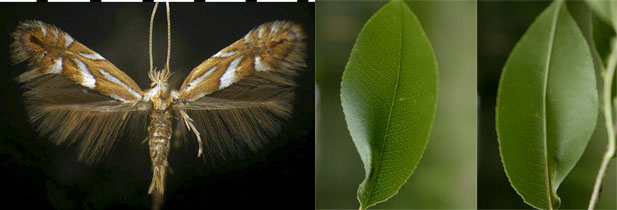
Figure 9. Phyllonorycter propinquinella. Adult, and leaf mine on black cherry, Prunus serotina (Rosaceae).
Phyllonorycter lucetiella (Fig. 10) feeds in an underside mine on American basswood, or linden, Tilia americana (Tiliaceae). The mine is conspicuously visible on the upperside of the leaf, due to removal of green parenchyma tissue from the upper wall; it is subrectangular in outline, and it remains fairly flat throughout most of the larval development period, becoming tentiform in the late stages.
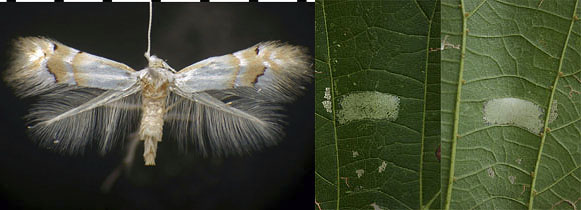
Figure 10. Phyllonorycter lucetiella. Adult, and leaf mine on American basswood, or linden, Tilia americana (Tiliaceae).
Phyllonorycter tiliacella (Fig. 11) also feeds on Tilia americana, but it makes an upperside mine that is round in outline and has a distinctive appearance, the upper wall being covered with small blackish spots; there is little or no evidence of the mine on the underside of the leaf.
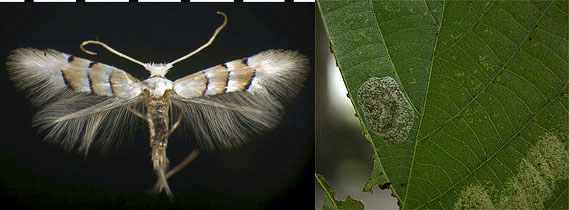
Figure 11. Phyllonorycter tiliacella. Adult, and leaf mine on American basswood, or linden, Tilia americana (Tiliaceae).
Phyllonorycter apparella (Fig. 12) feeds in an underside mine on cottonwood, Populus deltoides and other trees in the willow family (Salicaceae). The mine is yellowish, and it remains fairly flat throughout most of the larval development period, becoming tentiform in the late stages (somewhat reminiscent of the mine of P. lucetiella on Tilia). The adult moth is quite variable in coloration, as shown (the moths in Fig. 12 are from the same reared series). Davis and Deschka (2001) clarified the nomenclature of this moth, which previously was referred to as P. tremuloidiella in the Nearctic literature.

Figure 12. Phyllonorycter apparella. Adult, and leaf mine on cottonwood, Populus deltoides (Salicaceae).
Phyllonorycter scudderella (Fig. 13) feeds in an underside tentiform mine on willow, Salix sp. (Salicaceae).
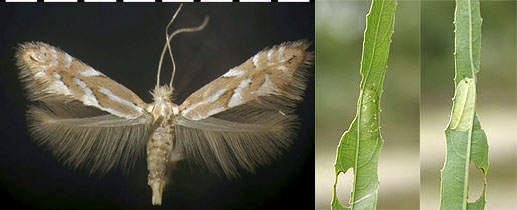
Figure 13. Phyllonorycter scudderella. Adult, and leaf mine on willow, Salix sp. (Salicaceae).
Phyllonorycter lucidicostella (Fig. 14) feeds in an underside tentiform mine on sugar maple, Acer saccharum (Sapindaceae) Another maple feeder, P. clemensella, is externally similar to P. lucidicostella but can be differentiated as noted by Braun (1908).

Figure 14. Phyllonorycter lucidicostella. Adult, and leaf mine on sugar maple, Acer saccharum (Sapindaceae).
Phyllonorycter olivaeformis (Fig. 15) is one of two species of Phyllonorycter that feed on hickory, Carya sp. (Juglandaceae), the other being P. caryaealbella. The larva of P. olivaeformis feeds in an underside tentiform mine; pupation occurs inside a black (frass-covered) ovate cocoon.
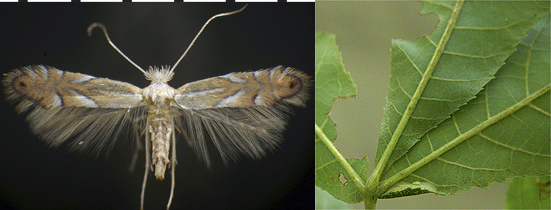
Figure 15. Phyllonorycter olivaeformis. Adult, and leaf mine on hickory, Carya sp. (Juglandaceae).
As in the other large lithocolletine genus, Cameraria, a number of different species of Phyllonorycter (including the following four spp.) feed on oaks, Quercus spp. (Fagaceae).
Phyllonorycter albanotella (Fig. 16) feeds in a small underside tentiform mine, either at the margin of the leaf or near the midvein. It pupates in a very thin-walled silken cocoon.
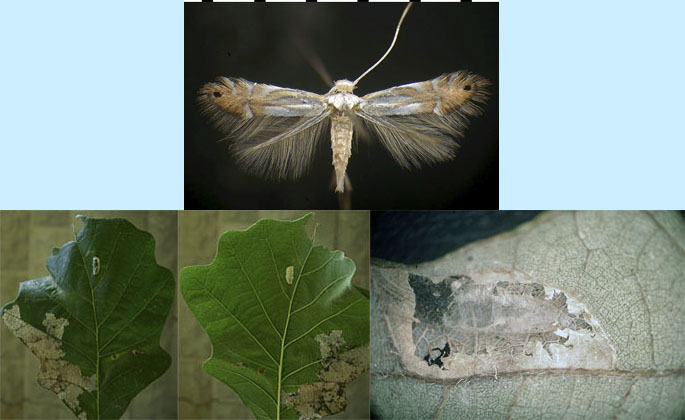
Figure 16. Phyllonorycter albanotella. Top: adult; bottom: left and center, upperside and underside, respectively, of leaf mine (adjacent to midvein, in subapical area of leaf) on oak, Quercus sp. (Fagaceae) (in addition to the P. albanotella leaf mine, the leaf in this image bears rather extensive skeletonization damage from an undetermined leaf-tying microlepidopteran larva); right, underside of leaf mine on white oak, Quercus alba, opened to show the diaphanous silken cocoon inside which a reared individual of P. albanotella pupated.
Phyllonorycter basistrigella (Fig. 17) feeds on shingle oak, Quercus imbricaria, and other oaks, in an underside tentiform mine inside which can be seen a narrow, ovate ring of black frass that is deposited around the edge of the cocoon.
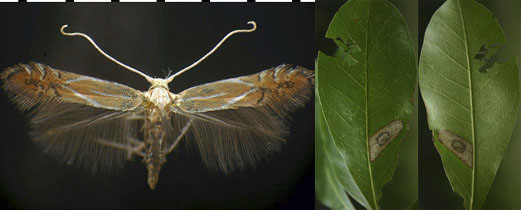
Figure 17. Phyllonorycter basistrigella. Adult, and leaf mine on shingle oak, Quercus imbricaria (Fagaceae).
Phyllonorycter fitchella (Fig. 18) feeds on white oak, Quercus alba, in an underside tentiform mine; no cocoon is formed within the mine.
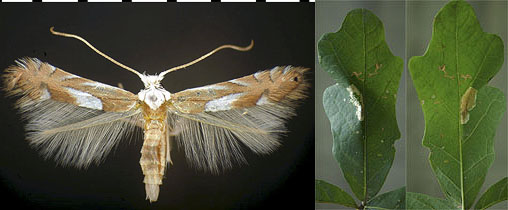
Figure 18. Phyllonorycter fitchella. Adult, and leaf mine on white oak, Quercus alba (Fagaceae).
Phyllonorycter aeriferella (Fig. 19) feeds in an underside mine on white oak, Quercus alba and other oak species. Pupation takes place inside an ovate cocoon that appears black due to its being covered with frass.
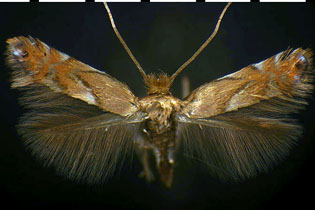
Figure 19. Phyllonorycter aeriferella. Adult, reared from a leaf mine on oak, Quercus sp. (Fagaceae).